Multi-Scale Detail–Noise Complementary Learning for Image Denoising
Abstract
:1. Introduction
- A novel multi-scale detail–noise complementary learning (MDNCL) network is introduced for the removal of AWGN and real-world noise. The MDNCL network incorporates two branches that extract rich detail features, effectively striking a balance between noise reduction and detail retention.
- Complementary learning is approached from two perspectives. Firstly, the MDNCL network facilitates the complementary learning of detail features and noise distribution, enabling more effective noise removal while preserving important image details. Secondly, the network facilitates the complementary learning of features between different network layers within the detail feature learning branch.
- The proposed FSU is proven to be an effective component in the MDNCL network. The FSU captures and leverages difference features within and between network layers. By avoiding the redundancy in image features and enhancing the complementarity between different network layers, the FSU further enhances the denoising performance.
2. Related Work
2.1. Multi-Scale Differential Feature Extraction
2.2. Deep CNNs for Image Denoising
2.3. Multi-Branch-Based Network for Image Application
3. Proposed Method
3.1. Noise Learning Branch
3.2. Detail Learning Branch
3.3. Fusion Module
3.4. Loss Function
4. Experiments
4.1. Dataset
- Training datasets: To train MDNCL for AWGN removal, we utilized the Berkeley segmentation dataset (BSD) [27], which consists of 432 original natural images with dimensions of . In order to enhance the training process and increase the number of training patches, each image was divided into 128 patches with dimensions of , resulting in a total of 55,296 image patches. Subsequently, random data augmentation techniques were applied to the training patches to enhance the generalization ability of MDNCL. These techniques included vertical flipping, rotation, etc. For denoising in grayscale images, we trained two versions of MDNCL, namely MDNCL, which utilizes known noise levels, and MDNCL-B, which performs denoising with blind noise levels. Similarly, for color images, we conducted experiments using CMDNCL and CMDNCL-B. Known noise levels were set to = 15, 25, and 50, where represents the standard deviation. The blind noise level was set within the range of .To train MDNCL for real-world noise removal, we used the Smartphone Image Denoising DATA (SIDD) sRGB track [28] with 160 scene instances, where each instance includes two pairs of high-resolution images. Each pair contained one noisy image and the corresponding clean image. In all, 320 pairs of images were used to train for real-world denoising.
- Test datasets: For grayscale testing of MDNCL, we evaluated its denoising performance using two datasets, namely the Berkeley segmentation dataset (BSD68) [29] and Set12 [29]. BSD68 consists of 68 images, while Set12 contains 12 images. These datasets were specifically used for AWGN removal. Regarding color image testing, we employed the CBSD68 [29], McMaster [30], and Kodak24 [31] datasets. CBSD68 consists of 68 images, the McMaster dataset consists of 18 images, and Kodak24 consists of 24 images. To assess real-world denoising performance, we utilized sets from the SIDD validation dataset and the Darmstadt Noise Data (DND) dataset [32]. The DND dataset comprises 50 pairs of images but does not provide ground-truth images. To evaluate the denoising results, we uploaded the denoised images to the official DND website, where we obtained the PSNR [33] and SSIM [34] measurements.
4.2. Implementation Details
4.3. Comparative Experiments
4.4. Ablation Experiment
- Role of network framework: To verify the effectiveness of complementary learning branches and the FSU module in MDNCL, we conducted ablation experiments on the Set12 dataset. For complementary learning branches, MDNCL was compared to a corresponding network with only one branch. For the FSU module, the MDNCL was compared to a corresponding network without an FSU. Specifically, we compared MDNCL with MDNCL-NLB, which only learns image details; MDNCL-DLB, which only learns noise; and MDNCL-FSU, which does not have an FSU. To ensure a fair comparison, all networks were trained using the same framework shown in Figure 1. The quantitative results of ablation experiments are shown in Table 6, highlighting the effectiveness of MDNCL.
- Role of loss function: The hyperparameter in the loss function was determined by a series of experiments. We conducted experiments on the Set12 dataset, changing the value of the hyperparameter to 0.4, 0.6, 0.8, 1.0, and 1.2. To ensure fair comparisons, all networks were trained using the same framework shown in Figure 1, and quantitative results of the ablation experiments are shown in Table 7.
4.5. Model Complexity Analysis
5. Conclusions
Author Contributions
Funding
Institutional Review Board Statement
Informed Consent Statement
Data Availability Statement
Acknowledgments
Conflicts of Interest
References
- Yang, X.; Yan, J.; Liao, W.; Yang, X.; Tang, J.; He, T. Scrdet++: Detecting small, cluttered and rotated objects via instance-level feature denoising and rotation loss smoothing. IEEE Trans. Pattern Anal. Mach. Intell. 2022, 45, 2384–2399. [Google Scholar] [CrossRef] [PubMed]
- Yazdi, M.; Bouwmans, T. New trends on moving object detection in video images captured by a moving camera: A survey. Comput. Sci. Rev. 2018, 28, 157–177. [Google Scholar] [CrossRef]
- Zatar, W.; Chen, G.; Nghiem, H. Ultrasonic Pulse-Echo Signals for Quantitative Assessment of Reinforced Concrete Anomalies. Appl. Sci. 2024, 14, 4860. [Google Scholar] [CrossRef]
- Huang, Z.; Zhang, J.; Zhang, Y.; Shan, H. DU-GAN: Generative Adversarial Networks with Dual-Domain U-Net-Based Discriminators for Low-Dose CT Denoising. IEEE Trans. Instrum. Meas. 2021, 71, 1–12. [Google Scholar] [CrossRef]
- Tian, C.; Fei, L.; Zheng, W.; Xu, Y.; Zuo, W.; Lin, C.W. Deep learning on image denoising: An overview. Neural Netw. 2020, 131, 251–275. [Google Scholar] [CrossRef] [PubMed]
- Aharon, M.; Elad, M.; Bruckstein, A. K-SVD: An algorithm for designing overcomplete dictionaries for sparse representation. IEEE Trans. Signal Process. 2006, 54, 4311–4322. [Google Scholar] [CrossRef]
- Dabov, K.; Foi, A.; Katkovnik, V.; Egiazarian, K. Image denoising by sparse 3-D transform-domain collaborative filtering. IEEE Trans. Image Process. 2007, 16, 2080–2095. [Google Scholar] [CrossRef] [PubMed]
- Wu, J.; Lee, X. An improved WNNM algorithm for image denoising. J. Phys. Conf. Ser. 2019, 1237, 022037. [Google Scholar] [CrossRef]
- Zhang, K.; Zuo, W.; Chen, Y.; Meng, D.; Zhang, L. Beyond a Gaussian denoiser: Residual learning of deep CNN for image denoising. IEEE Trans. Image Process. 2017, 26, 3142–3155. [Google Scholar] [CrossRef]
- Zhang, K.; Zuo, W.; Zhang, L. FFDNet: Toward a fast and flexible solution for CNN-based image denoising. IEEE Trans. Image Process. 2018, 27, 4608–4622. [Google Scholar] [CrossRef]
- Huang, G.; Liu, Z.; Van Der Maaten, L.; Weinberger, K.Q. Densely connected convolutional networks. In Proceedings of the IEEE Conference on Computer Vision and Pattern Recognition, Honolulu, HI, USA, 21–26 July 2017; pp. 4700–4708. [Google Scholar]
- Gurrola-Ramos, J.; Dalmau, O.; Alarcón, T.E. A Residual Dense U-Net Neural Network for Image Denoising. IEEE Access 2021, 9, 31742–31754. [Google Scholar] [CrossRef]
- Qu, Q.; Song, Y.; Chen, J. Denoising Multiscale Back-Projection Feature Fusion for Underwater Image Enhancement. Appl. Sci. 2024, 14, 4395. [Google Scholar] [CrossRef]
- Liu, G.; Dang, M.; Liu, J. True wide convolutional neural network for image denoising. Inf. Sci. 2022, 610, 171–184. [Google Scholar] [CrossRef]
- Wu, W.; Ge, A.; Lv, G. DCANet: Dual Convolutional Neural Network with Attention for Image Blind Denoising. arXiv 2023, arXiv:2304.01498. [Google Scholar]
- Huang, Z.; You, H. MFSFNet: Multi-scale feature subtraction fusion network for remote sensing image change detection. Remote Sens. 2023, 15, 3740. [Google Scholar] [CrossRef]
- Gan, Y.; Xu, X.; Sun, W.; Lin, L. Monocular depth estimation with affinity, vertical pooling, and label enhancement. In Proceedings of the European Conference on Computer Vision (ECCV), Munich, Germany, 8–14 September 2018; pp. 224–239. [Google Scholar]
- Ronneberger, O.; Fischer, P.; Brox, T. U-net: Convolutional networks for biomedical image segmentation. In Proceedings of the Medical Image Computing and Computer-Assisted Intervention–MICCA, Munich, Germany, 5–9 October 2015; pp. 234–241. [Google Scholar]
- Zhou, Z.; Rahman Siddiquee, M.M.; Tajbakhsh, N.; Liang, J. Unet++: A nested u-net architecture for medical image segmentation. In Proceedings of the Deep Learning in Medical Image Analysis and Multimodal Learning for Clinical Decision Support, Granada, Spain, 20 September 2018; Springer: Cham, Switzerland, 2018; pp. 3–11. [Google Scholar]
- Tian, C.; Xu, Y.; Li, Z.; Zuo, W.; Fei, L.; Liu, H. Attention-guided CNN for image denoising. Neural Netw. 2020, 124, 117–129. [Google Scholar] [CrossRef]
- Zhang, Q.; Xiao, J.; Tian, C.; Chun-Wei Lin, J. A Robust Deformed Convolutional Neural Network (CNN) for Image Denoising. CAAI Trans. Intell. Technol. 2023, 8, 331–342. [Google Scholar] [CrossRef]
- Shen, H.; Zhao, Z.Q.; Zhang, W. Adaptive dynamic filtering network for image denoising. In Proceedings of the AAAI Conference on Artificial Intelligence, Seattle, WA, USA, 7–14 February 2023; Volume 37, pp. 2227–2235. [Google Scholar]
- Neshatavar, R.; Liu, P.; Pang, J.; Mei, T.; Barnes, N.; Petersson, L.; Harandi, M. CVF-SID: Cyclic multi-variate function for self-supervised image denoising by disentangling noise from image. In Proceedings of the IEEE/CVF Conference on Computer Vision and Pattern Recognition, New Orleans, LA, USA, 19–24 June 2022; pp. 17583–17591. [Google Scholar]
- Li, X.; Zhang, K.; Zuo, W.; Zhang, L.; Zhang, L.; Zhu, X.; Zhang, Y.; Zhang, L. Learning omni-frequency region-adaptive representations for real image super-resolution. In Proceedings of the AAAI Conference on Artificial Intelligence; Association for the Advancement of Artificial Intelligence: Washington, DC, USA, 2021; Volume 35, pp. 1975–1983. [Google Scholar]
- Wang, J.; Lu, Y.; Lu, G. Lightweight image denoising network with four-channel interaction transform. Image Vis. Comput. 2023, 137, 104766. [Google Scholar] [CrossRef]
- Allen, D.M. Mean square error of prediction as a criterion for selecting variables. Technometrics 1971, 13, 469–475. [Google Scholar] [CrossRef]
- Li, H.; Cai, J.; Nguyen, T.N.A.; Zheng, J. A benchmark for semantic image segmentation. In Proceedings of the IEEE International Conference on Multimedia and Expo, San Jose, CA, USA, 15–19 July 2013; pp. 1–6. [Google Scholar]
- Abdelhamed, A.; Lin, S.; Brown, M.S. A high-quality denoising dataset for smartphone cameras. In Proceedings of the IEEE/CVF Conference on Computer Vision and Pattern Recognition, Salt Lake City, UT, USA, 18–22 June 2018; pp. 1692–1700. [Google Scholar]
- Li, H.; Xia, S.; Zhou, B.; Peng, J. The growth mechanism of grain boundary carbide in Alloy 690. Mater. Charact. 2013, 81, 1–6. [Google Scholar] [CrossRef]
- Zhang, L.; Wu, X.; Buades, A.; Li, X. Color demosaicking by local directional interpolation and nonlocal adaptive thresholding. J. Electron. Imaging 2011, 20, 023016. [Google Scholar]
- Franzen, R. Kodak lossless true color image suite. Photocd pcd0992 1999, 4, 2. [Google Scholar]
- Plotz, T.; Roth, S. Benchmarking denoising algorithms with real photographs. In Proceedings of the IEEE Conference on Computer Vision and Pattern Recognition, Honolulu, HI, USA, 21–26 July 2017; pp. 2750–2759. [Google Scholar]
- Hore, A.; Ziou, D. Image quality metrics: PSNR vs. SSIM. In Proceedings of the international conference on pattern recognition, Istanbul, Turkey, 23–26 August 2010; pp. 2366–2369. [Google Scholar]
- Wang, Z.; Bovik, A.C.; Sheikh, H.R.; Simoncelli, E.P. Image quality assessment: From error visibility to structural similarity. IEEE Trans. Image Process. 2004, 13, 600–612. [Google Scholar] [CrossRef] [PubMed]
- Gu, S.; Zhang, L.; Zuo, W.; Feng, X. Weighted nuclear norm minimization with application to image denoising. In Proceedings of the IEEE Conference on Computer Vision and Pattern Recognition, Columbus, OH, USA, 23–28 June 2014; pp. 2862–2869. [Google Scholar]
- Tian, C.; Xu, Y.; Zuo, W. Image denoising using deep CNN with batch renormalization. Neural Netw. 2020, 121, 461–473. [Google Scholar] [CrossRef] [PubMed]
- El Helou, M.; Süsstrunk, S. Blind Universal Bayesian Image Denoising with Gaussian Noise Level Learning. IEEE Trans. Image Process. 2020, 29, 4885–4897. [Google Scholar] [CrossRef] [PubMed]
- Quan, Y.; Chen, Y.; Shao, Y.; Teng, H.; Xu, Y.; Ji, H. Image denoising using complex-valued deep CNN. Pattern Recognit. 2021, 111, 107639. [Google Scholar] [CrossRef]
- Tian, C.; Zheng, M.; Zuo, W.; Zhang, B.; Zhang, Y.; Zhang, Y. Multi-stage image denoising with the wavelet transform. Pattern Recognit. 2023, 134, 109050. [Google Scholar] [CrossRef]
- Zhong, R.; Zhang, Q. DRFENet: An Improved Deep Learning Neural Network via Dilated Skip Convolution for Image Denoising Application. Appl. Sci. 2022, 13, 28. [Google Scholar] [CrossRef]
- Guo, S.; Yan, Z.; Zhang, K.; Zuo, W.; Zhang, L. Toward convolutional blind denoising of real photographs. In Proceedings of the IEEE/CVF Conference on Computer Vision and Pattern Recognition, Long Beach, CA, USA, 16–20 June 2019; pp. 1712–1722. [Google Scholar]
- Li, B.; Liu, X.; Hu, P.; Wu, Z.; Lv, J.; Peng, X. All-in-one image restoration for unknown corruption. In Proceedings of the IEEE/CVF Conference on Computer Vision and Pattern Recognition, New Orleans, LA, USA, 19–24 June 2022; pp. 17452–17462. [Google Scholar]
- Vo, D.M.; Nguyen, D.M.; Le, T.P.; Lee, S.W. HI-GAN: A hierarchical generative adversarial network for blind denoising of real photographs. Inf. Sci. 2021, 570, 225–240. [Google Scholar] [CrossRef]
- Li, J.; Zhang, Z.; Zuo, W. TBSN: Transformer-Based Blind-Spot Network for Self-Supervised Image Denoising. arXiv 2024, arXiv:2404.07846. [Google Scholar]
- Wu, W.; Ge, A.; Lv, G.; Xia, Y.; Zhang, Y. Two-stage Progressive Residual Dense Attention Network for Image Denoising. arXiv 2024, arXiv:2401.02831. [Google Scholar]
- Xu, J.; Zhang, L.; Zhang, D.; Feng, X. Multi-channel weighted nuclear norm minimization for real color image denoising. In Proceedings of the IEEE International Conference on Computer Vision, Venice, Italy, 22–29 October 2017; pp. 1096–1104. [Google Scholar]
- Zhang, K.; Zuo, W.; Gu, S.; Zhang, L. Learning deep CNN denoiser prior for image restoration. In Proceedings of the IEEE Conference on Computer Vision and Pattern Recognition, Honolulu, HI, USA, 21–26 July 2017; pp. 3929–3938. [Google Scholar]
- Chang, M.; Li, Q.; Feng, H.; Xu, Z. Spatial-adaptive network for single image denoising. In Proceedings of the Computer Vision-ECCV 2020: 16th European Conference, Glasgow, UK, 23–28 August 2020; pp. 171–187. [Google Scholar]
- Zamir, S.W.; Arora, A.; Khan, S.; Hayat, M.; Khan, F.S.; Yang, M.H.; Shao, L. Cycleisp: Real image restoration via improved data synthesis. In Proceedings of the IEEE/CVF Conference on Computer Vision and Pattern Recognition, Seattle, WA, USA, 14–19 June 2020; pp. 2696–2705. [Google Scholar]
- Yue, Z.; Yong, H.; Zhao, Q.; Meng, D.; Zhang, L. Variational denoising network: Toward blind noise modeling and removal. In Proceedings of theAdvances in Neural Information Processing Systems, Vancouver, BC, Canada, 8–14 December 2019; Volume 32. [Google Scholar]
- Kim, Y.; Soh, J.W.; Park, G.Y.; Cho, N.I. Transfer learning from synthetic to real-noise denoising with adaptive instance normalization. In Proceedings of the IEEE/CVF Conference on Computer Vision and Pattern Recognition, Seattle, WA, USA, 14–19 June 2020; pp. 3482–3492. [Google Scholar]
- Soh, J.W.; Cho, N.I. Variational deep image restoration. IEEE Trans. Image Process. 2022, 31, 4363–4376. [Google Scholar] [CrossRef] [PubMed]
- Kim, Y.; Soh, J.W.; Cho, N.I. Adaptively tuning a convolutional neural network by gate process for image denoising. IEEE Access 2019, 7, 63447–63456. [Google Scholar] [CrossRef]
- Tian, C.; Zheng, M.; Zuo, W.; Zhang, S.; Zhang, Y.; Lin, C.W. A cross Transformer for image denoising. Inf. Fusion 2024, 102, 102043. [Google Scholar] [CrossRef]
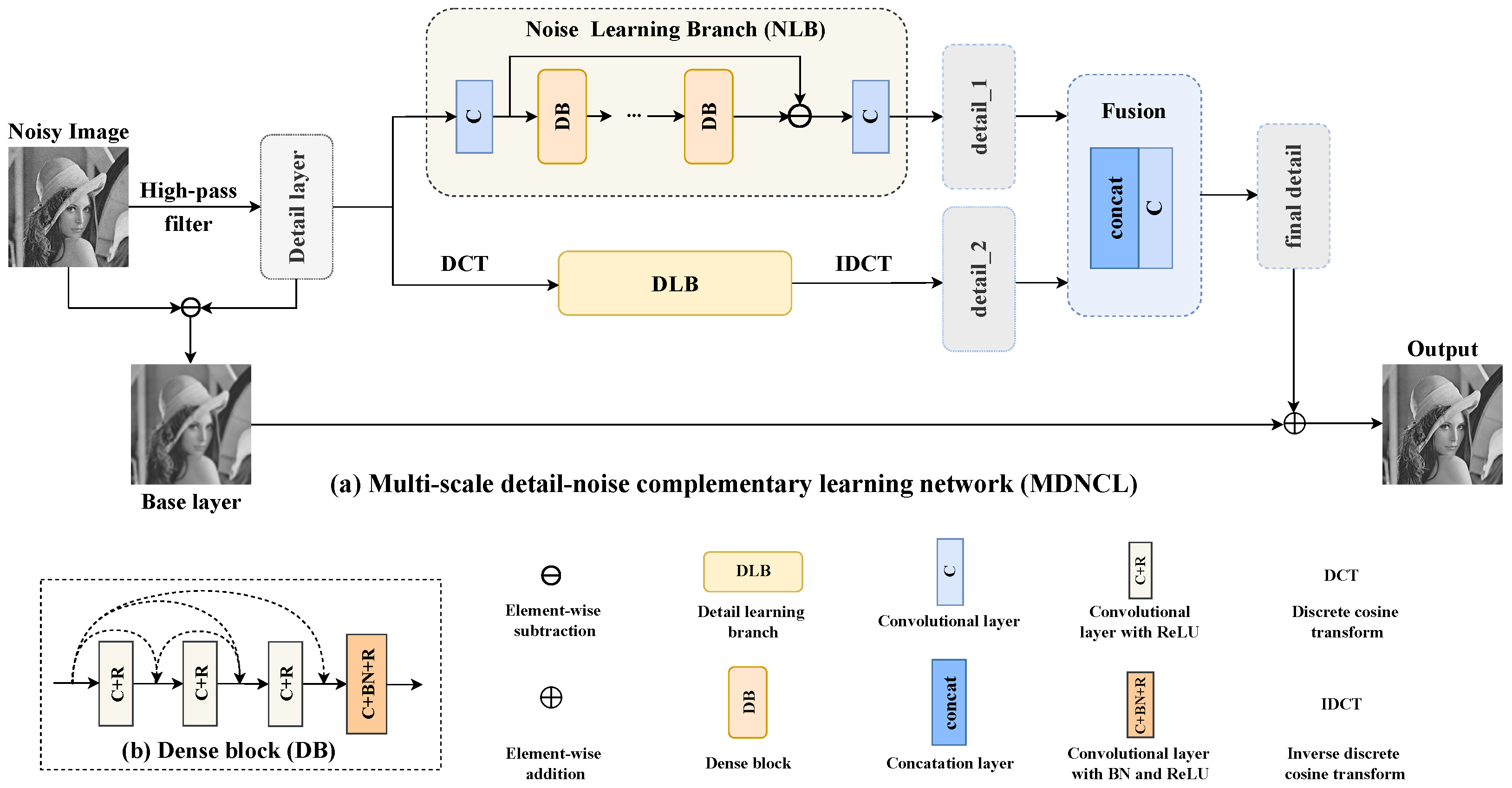


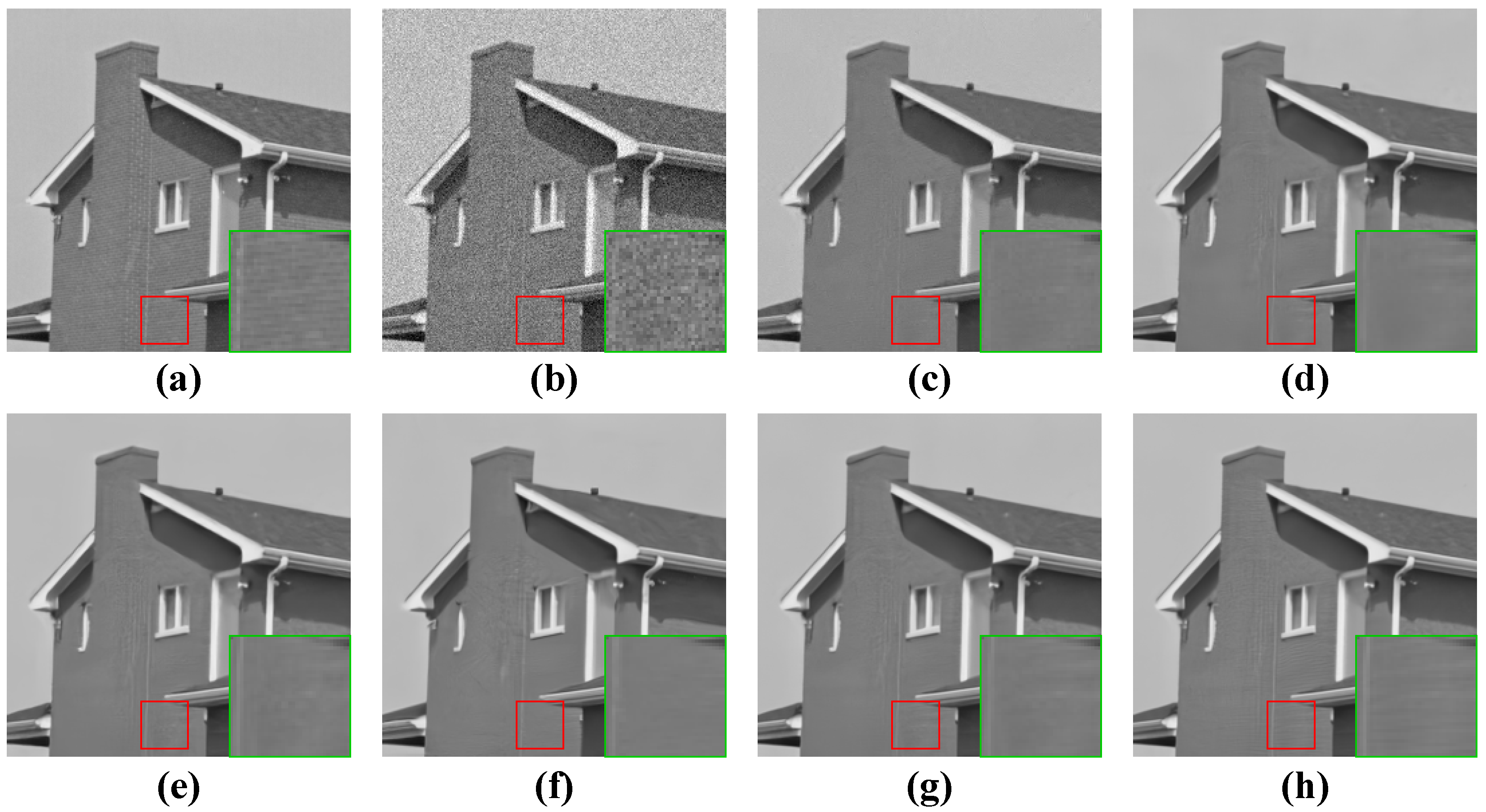
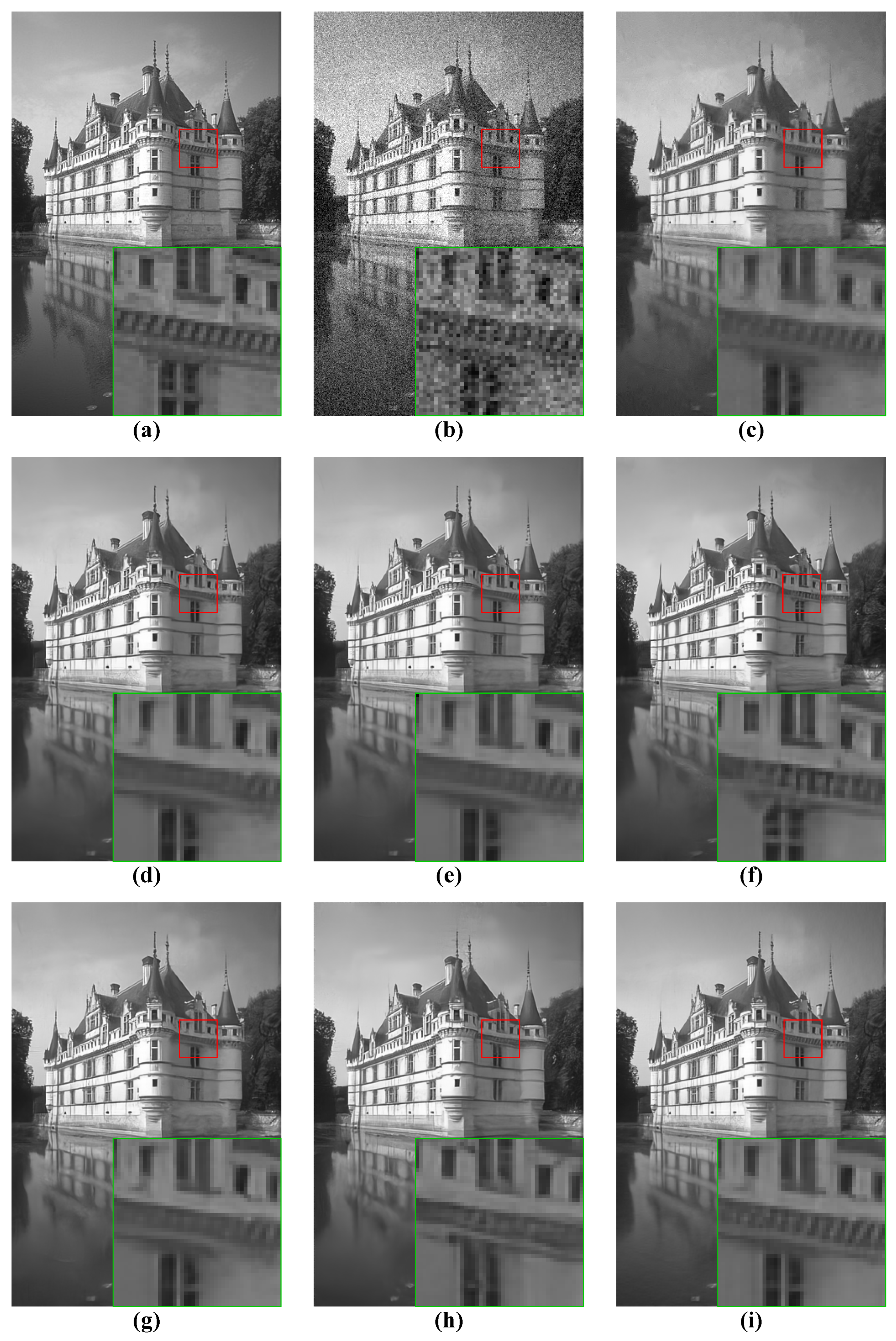




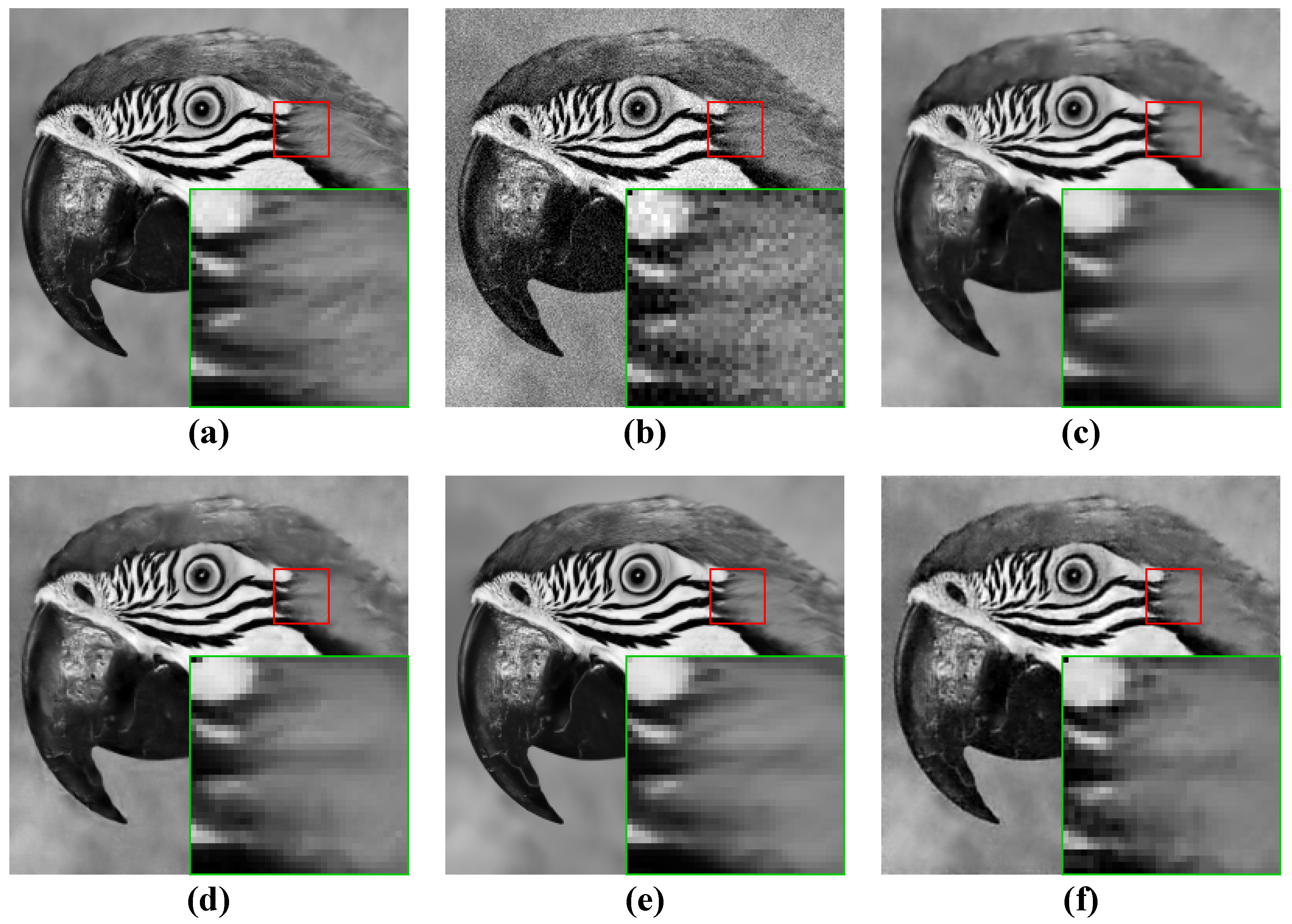
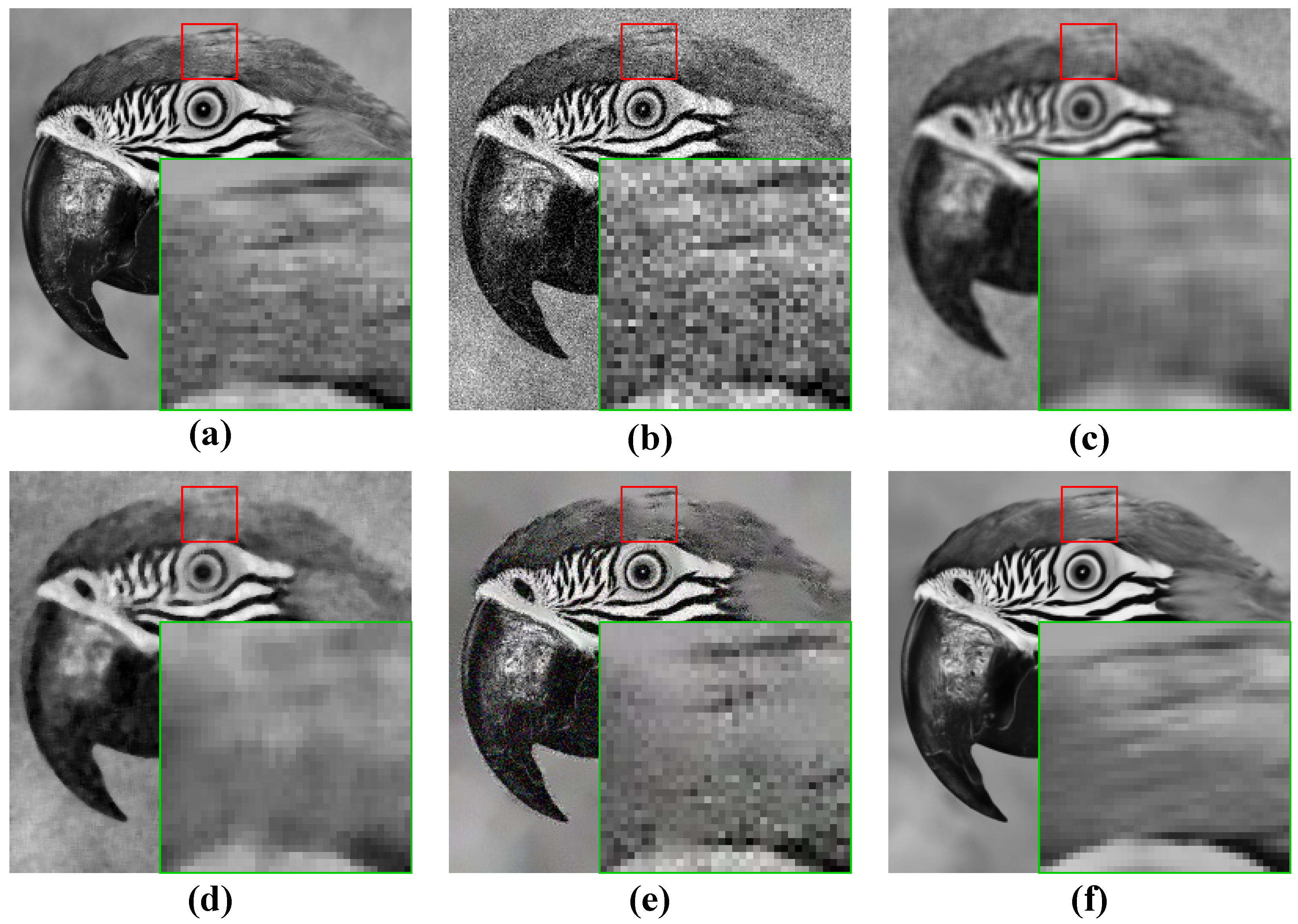
| Parameter | Value |
|---|---|
| Batch size | 16 |
| Epochs | 90 |
| Initial learning rate | 0.0001 |
| 0.9 | |
| 0.999 | |
| 1 | |
| Xavier initialization | Draw weights from a normal distribution with a mean of 0 |
| Method | |||
|---|---|---|---|
| BM3D [7] | 31.07/0.8729 | 28.57/0.8042 | 25.62/0.6817 |
| WNNM [35] | 31.37/0.8777 | 28.83/0.8103 | 25.87/0.6975 |
| DnCNN [9] | 31.72/0.8902 | 29.23/0.8288 | 26.23/0.7180 |
| FFDNet [10] | 31.63/0.8901 | 29.19/0.8298 | 26.29/0.7262 |
| ADNet [20] | 31.74/0.8910 | 29.25/0.8285 | 26.29/0.7211 |
| CDNet [38] | 31.74/0.8915 | 29.28/0.8312 | 26.36/0.7229 |
| BRDNet [36] | 31.72/0.8910 | 29.24/0.8295 | 26.28/0.7232 |
| DRFENet [40] | 31.76/0.8920 | 29.26/0.8301 | 26.29/0.7230 |
| MWDCNN [39] | 31.77/0.8919 | 29.28/0.8305 | 26.29/0.7229 |
| MDNCL (ours) | 31.82/0.8923 | 29.30/0.8316 | 26.38/0.7242 |
| MDNCL-B (ours) | 31.76/0.8919 | 29.25/0.8304 | 26.31/0.7234 |
| Image | C.man | House | Peppers | Starfish | Monarch | Airplane | Parrot | Lena | Barbara | Boat | Man | Couple | Average |
|---|---|---|---|---|---|---|---|---|---|---|---|---|---|
| Noise Level | |||||||||||||
| BM3D [7] | 31.91 | 34.93 | 32.69 | 31.14 | 31.85 | 31.07 | 31.37 | 34.26 | 33.10 | 32.13 | 31.92 | 32.10 | 32.37/0.8953 |
| WNNM [35] | 32.17 | 35.13 | 32.99 | 31.82 | 32.71 | 31.39 | 31.62 | 34.27 | 33.60 | 32.27 | 32.11 | 32.17 | 32.70/0.8944 |
| DnCNN [9] | 32.59 | 34.99 | 33.24 | 32.13 | 33.25 | 31.67 | 31.88 | 34.58 | 32.61 | 32.42 | 32.43 | 32.43 | 32.85/0.9029 |
| FFDNet [10] | 32.43 | 35.07 | 33.24 | 31.99 | 32.66 | 31.57 | 31.87 | 34.62 | 32.54 | 32.38 | 32.41 | 32.46 | 32.77/0.9027 |
| CDNet [38] | 32.64 | 34.94 | 33.28 | 32.17 | 33.30 | 31.72 | 31.93 | 34.52 | 32.66 | 32.36 | 32.49 | 32.47 | 32.87/0.9034 |
| ADNet [20] | 32.81 | 35.22 | 33.49 | 32.17 | 33.17 | 31.86 | 31.96 | 34.71 | 32.80 | 32.57 | 32.47 | 32.58 | 32.98/0.9039 |
| BRDNet [36] | 32.80 | 35.27 | 33.47 | 32.24 | 33.35 | 31.82 | 32.00 | 34.75 | 32.93 | 32.55 | 32.50 | 32.62 | 33.03/0.9038 |
| DRFENet [40] | 32.60 | 35.19 | 33.42 | 32.19 | 33.41 | 31.76 | 31.96 | 34.72 | 32.73 | 32.54 | 32.45 | 32.55 | 32.96/0.9045 |
| MWDCNN [39] | 32.53 | 35.09 | 33.29 | 32.28 | 33.20 | 31.74 | 31.97 | 34.64 | 32.65 | 32.49 | 32.46 | 32.52 | 32.91/0.9043 |
| MDNCL (ours) | 32.91 | 35.46 | 33.53 | 32.31 | 33.68 | 31.94 | 32.08 | 34.81 | 33.15 | 32.62 | 32.56 | 32.68 | 33.14/0.9065 |
| MDNCL-B (ours) | 32.79 | 35.34 | 33.46 | 32.18 | 33.29 | 31.84 | 32.01 | 34.73 | 32.77 | 32.52 | 32.50 | 32.63 | 33.01/0.9056 |
| Noise Level | |||||||||||||
| BM3D [7] | 29.45 | 32.85 | 30.16 | 28.56 | 29.25 | 28.42 | 28.93 | 32.07 | 30.71 | 29.90 | 29.61 | 29.71 | 29.97/0.8499 |
| WNNM [35] | 29.64 | 33.22 | 30.42 | 29.03 | 29.84 | 28.69 | 29.15 | 32.24 | 31.24 | 30.03 | 29.76 | 29.82 | 30.26/0.8451 |
| DnCNN [9] | 30.18 | 33.06 | 30.87 | 29.41 | 30.28 | 29.13 | 29.43 | 32.44 | 30.00 | 30.21 | 30.10 | 30.12 | 30.43/0.8608 |
| FFDNet [10] | 30.10 | 33.28 | 30.93 | 29.32 | 30.08 | 29.04 | 29.44 | 32.57 | 30.01 | 30.25 | 30.11 | 30.20 | 30.44/0.8638 |
| CDNet [38] | 30.21 | 32.98 | 30.78 | 29.51 | 30.35 | 29.20 | 29.53 | 32.40 | 30.05 | 30.15 | 30.08 | 30.11 | 30.53/0.8646 |
| ADNet [20] | 30.34 | 33.41 | 31.14 | 29.41 | 30.39 | 29.17 | 29.49 | 32.61 | 30.25 | 30.37 | 30.08 | 30.24 | 30.58/0.8637 |
| BRDNet [36] | 31.39 | 33.41 | 31.04 | 29.46 | 30.50 | 29.20 | 29.55 | 32.65 | 30.34 | 30.33 | 30.14 | 30.28 | 30.61/0.8639 |
| DRFENet [40] | 30.26 | 33.41 | 31.07 | 29.49 | 29.49 | 29.12 | 29.46 | 32.57 | 30.02 | 30.29 | 30.07 | 30.17 | 30.54/0.8642 |
| MWDCNN [39] | 30.19 | 33.33 | 30.85 | 29.66 | 30.55 | 29.16 | 29.48 | 32.67 | 30.21 | 30.28 | 30.10 | 30.13 | 30.55/0.8645 |
| MDNCL (ours) | 30.52 | 33.66 | 31.18 | 29.69 | 30.75 | 29.34 | 29.68 | 32.84 | 30.81 | 30.48 | 30.24 | 30.44 | 30.80/0.8679 |
| MDNCL-B (ours) | 30.46 | 33.55 | 31.11 | 29.43 | 30.52 | 29.23 | 29.59 | 32.69 | 30.34 | 30.35 | 30.16 | 30.32 | 30.65/0.8673 |
| Noise Level | |||||||||||||
| BM3D [7] | 26.13 | 29.69 | 26.68 | 25.04 | 25.82 | 25.10 | 25.90 | 29.05 | 27.22 | 26.78 | 26.81 | 26.46 | 26.72/0.7654 |
| WNNM [35] | 26.45 | 30.33 | 26.95 | 25.44 | 26.32 | 25.42 | 26.14 | 29.25 | 27.79 | 26.97 | 26.94 | 26.64 | 27.05/0.7568 |
| DnCNN [9] | 27.03 | 30.00 | 27.32 | 25.70 | 26.78 | 25.87 | 26.48 | 29.39 | 26.22 | 27.20 | 27.24 | 26.90 | 27.18/0.7829 |
| FFDNet [10] | 27.05 | 30.37 | 27.54 | 25.75 | 26.81 | 25.89 | 26.57 | 29.66 | 26.45 | 27.33 | 27.29 | 27.08 | 27.32/0.7916 |
| CDNet [38] | 27.02 | 30.48 | 27.40 | 25.93 | 27.12 | 25.85 | 26.58 | 29.70 | 26.50 | 27.15 | 27.37 | 27.05 | 27.38/0.7924 |
| ADNet [20] | 27.31 | 30.59 | 27.69 | 25.70 | 26.90 | 25.88 | 26.56 | 29.59 | 26.64 | 27.35 | 27.17 | 27.07 | 27.37/0.7875 |
| BRDNet [36] | 27.44 | 30.53 | 27.67 | 25.77 | 26.97 | 25.93 | 26.66 | 29.73 | 26.85 | 27.38 | 27.27 | 27.17 | 27.45/0.7898 |
| DRFENet [40] | 27.10 | 30.57 | 27.54 | 25.83 | 26.89 | 25.83 | 26.42 | 29.60 | 26.53 | 27.31 | 27.27 | 27.06 | 27.33/0.7894 |
| MWDCNN [39] | 26.99 | 30.58 | 27.34 | 25.85 | 27.02 | 25.93 | 26.48 | 29.63 | 26.60 | 27.23 | 27.27 | 27.11 | 27.34/0.7897 |
| MDNCL (ours) | 27.64 | 30.96 | 27.79 | 26.00 | 27.15 | 26.08 | 26.80 | 29.95 | 27.40 | 27.55 | 27.39 | 27.37 | 27.67/0.7955 |
| MDNCL-B (ours) | 27.51 | 30.53 | 27.69 | 25.74 | 26.92 | 25.91 | 26.67 | 29.67 | 26.79 | 27.36 | 27.28 | 27.14 | 27.43/0.7923 |
| Datasets | Method | ||||
|---|---|---|---|---|---|
| CBSD68 | CBM3D [7] | 33.52/0.925 | 30.71/0.872 | 27.38/0.767 | 25.74/- |
| CDnCNN-B [9] | 33.95/0.929 | 31.29/0.883 | 28.01/0.790 | - | |
| FFDNet [10] | 33.86/0.929 | 31.18/0.882 | 27.95/0.789 | 26.24/0.593 | |
| ADNet [20] | 34.02/0.933 | 31.34/0.889 | 28.05/0.797 | 26.33/0.606 | |
| BUIFD [37] | 33.65/0.930 | 30.76/0.882 | 26.61/0.777 | - | |
| AirNet [42] | 33.92/0.933 | 31.26/0.888 | 28.01/0.798 | - | |
| CMDNCL (ours) | 34.21/0.939 | 31.53/0.892 | 28.26/0.802 | 26.49/0.613 | |
| CMDNCL-B (ours) | 34.12/0.934 | 31.46/0.889 | 28.22/0.802 | 26.41/0.609 | |
| Kodak24 | CBM3D [7] | 34.28/0.916 | 31.68/0.868 | 28.46/0.775 | 26.82/- |
| CDnCNN-B [9] | 34.73/0.920 | 32.23/0.876 | 29.02/0.791 | - | |
| FFDNet [10] | 34.55/0.922 | 32.11/0.878 | 28.99/0.794 | 27.25/0.733 | |
| ADNet [20] | 34.76/0.924 | 32.26/0.882 | 29.10/0.798 | 27.40/0.739 | |
| BUIFD [37] | 34.41/0.923 | 31.77/0.879 | 27.74/0.786 | - | |
| AirNet [42] | 34.68/0.924 | 32.21/0.882 | 29.06/0.799 | - | |
| MWDCNN [39] | 34.91/0.927 | 32.40/0.886 | 29.26/0.806 | 27.55/0.749 | |
| CMDNCL (ours) | 35.09/0.934 | 32.57/0.889 | 29.46/0.813 | 28.61/0.759 | |
| CMDNCL-B (ours) | 35.01/0.930 | 32.49/0.885 | 29.37/0.809 | 28.02/0.751 | |
| McMaster | CBM3D [7] | 34.06/0.915 | 31.66/0.874 | 28.51/0.793 | - |
| CDnCNN-B [9] | 34.80/0.904 | 32.47/0.869 | 29.21/0.799 | - | |
| FFDNet [10] | 34.47/0.922 | 32.25/0.886 | 29.14/0.815 | - | |
| ADNet [20] | 34.93/0.927 | 32.56/0.894 | 29.36/0.825 | - | |
| BUIFD [37] | 33.84/0.901 | 31.06/0.847 | 26.20/0.733 | - | |
| AirNet [42] | 34.70/0.925 | 32.44/0.891 | 29.26/0.822 | - | |
| CMDNCL (ours) | 35.19/0.939 | 32.92/0.913 | 29.69/0.839 | - | |
| CMDNCL-B (ours) | 35.13/0.930 | 32.86/0.907 | 29.59/0.833 | - |
| Test Data | Method | BM3D [7] | WNNM [35] | CBDNet [41] | HI-GAN [43] | TBSN [44] | MDNCL |
|---|---|---|---|---|---|---|---|
| SIDD | PSNR | 25.65 | 25.78 | 38.68 | 38.47 | 37.78 | 39.31 |
| SSIM | 0.685 | 0.685 | 0.809 | 0.900 | 0.940 | 0.928 | |
| DND | PSNR | 34.51 | 34.67 | 38.06 | 39.32 | 39.08 | 39.37 |
| SSIM | 0.851 | 0.865 | 0.942 | 0.952 | 0.945 | 0.959 |
| Method | |||
|---|---|---|---|
| MDNCL-DLB | 32.46/0.8913 | 30.19/0.8589 | 27.17/0.7821 |
| MDNCL-NLB | 31.93/0.8794 | 29.82/0.8497 | 26.89/0.7690 |
| MDNCL-FSU | 28.89/0.8623 | 29.48/0.8446 | 24.11/0.7413 |
| MDNCL | 33.14/0.9065 | 30.80/0.8679 | 27.67/0.7955 |
| 0.4 | 31.90/0.8419 | 29.56/0.8449 | 26.47/0.7553 |
| 0.6 | 32.77/0.8814 | 29.46/0.8577 | 27.45/0.7690 |
| 0.8 | 32.57/0.8763 | 29.80/0.8593 | 27.54/0.7723 |
| 1.0 | 33.14/0.9065 | 30.80/0.8679 | 27.67/0.7955 |
| 1.2 | 31.78/0.8801 | 29.40/0.8470 | 26.45/0.7529 |
| Device | Model | 256 × 256 | 512 × 512 | 1024 × 1024 | |||
|---|---|---|---|---|---|---|---|
| Grayscale | Color | Grayscale | Color | Grayscale | Color | ||
| BM3D [7] | 0.446 | 0.589 | 2.274 | 3.661 | 9.687 | 12.788 | |
| CPU | TWSC [45] | 12.294 | 34.361 | 53.011 | 140.922 | 220.997 | 608.477 |
| MCWNNM [46] | - | 62.732 | - | 278.073 | - | 1120.332 | |
| IRCNN [47] | 0.030 | 0.030 | 0.030 | 0.030 | 0.030 | 0.030 | |
| DnCNN-B [9] | 0.032 | 0.032 | 0.037 | 0.037 | 0.057 | 0.057 | |
| FFDNet [10] | 0.031 | 0.030 | 0.031 | 0.030 | 0.032 | 0.030 | |
| BUIFD [37] | 0.035 | 0.037 | 0.050 | 0.053 | 0.112 | 0.123 | |
| ADNet [20] | 0.031 | 0.033 | 0.035 | 0.045 | 0.051 | 0.093 | |
| GPU | SADNet [48] | 0.030 | 0.030 | 0.043 | 0.044 | 0.101 | 0.102 |
| CycleISP [49] | - | 0.055 | - | 0.156 | - | 0.545 | |
| AirNet [42] | - | 0.143 | - | 0.498 | - | 2.501 | |
| VDN [50] | 0.144 | 0.162 | 0.607 | 0.597 | 2.367 | 2.376 | |
| AINDNet [51] | - | 0.531 | - | 2.329 | - | 9.573 | |
| VDIR [52] | - | 0.385 | - | 1.622 | - | 6.690 | |
| MDNCL | 0.279 | 0.316 | 0.574 | 0.697 | 2.013 | 2.174 | |
Disclaimer/Publisher’s Note: The statements, opinions and data contained in all publications are solely those of the individual author(s) and contributor(s) and not of MDPI and/or the editor(s). MDPI and/or the editor(s) disclaim responsibility for any injury to people or property resulting from any ideas, methods, instructions or products referred to in the content. |
© 2024 by the authors. Licensee MDPI, Basel, Switzerland. This article is an open access article distributed under the terms and conditions of the Creative Commons Attribution (CC BY) license (https://creativecommons.org/licenses/by/4.0/).
Share and Cite
Cui, Y.; Shi, M.; Jiang, J. Multi-Scale Detail–Noise Complementary Learning for Image Denoising. Appl. Sci. 2024, 14, 7044. https://doi.org/10.3390/app14167044
Cui Y, Shi M, Jiang J. Multi-Scale Detail–Noise Complementary Learning for Image Denoising. Applied Sciences. 2024; 14(16):7044. https://doi.org/10.3390/app14167044
Chicago/Turabian StyleCui, Yan, Mingyue Shi, and Jielin Jiang. 2024. "Multi-Scale Detail–Noise Complementary Learning for Image Denoising" Applied Sciences 14, no. 16: 7044. https://doi.org/10.3390/app14167044






